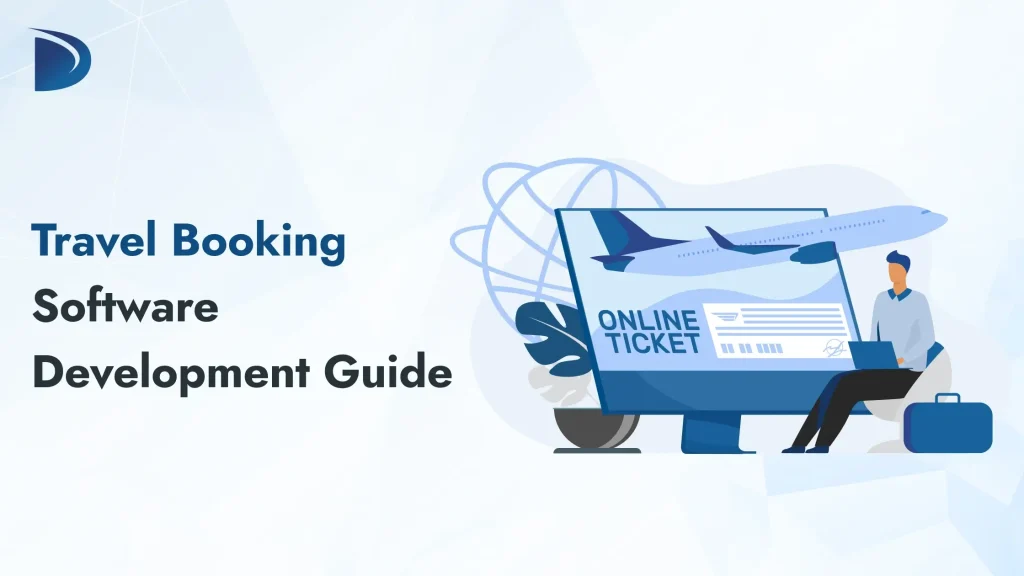Table of Contents
Booking a trip today is very different from the past. You no longer need to call a travel agent or look through brochures; most people simply go online, search a few sites, and book within minutes. Behind this simple experience, a lot of software does the heavy lifting.
Travel companies, tour operators, and small agencies are now developing their own booking systems to remain competitive. They seek greater control, improved user experience, and features customized to their business.
This blog is for anyone interested in how travel booking software is built. We will explain what it does, how it works behind the scenes, which tools and technologies are used, and what challenges you may encounter. Whether you plan to build one or simply want to understand how these platforms operate, you are in the right place. This Travel Booking Software Development Guide offers a practical approach to building and understanding travel booking systems.
What is Travel Booking Software?
Travel booking software is a tool that allows users to search for, compare, and book travel services such as flights, hotels, rental cars, and tour packages, all in one place. It eliminates the need to call a travel agent or visit multiple websites by providing everything on a single, easy-to-use platform.
For customers, it provides a quick and convenient way to plan trips. For travel businesses, it helps manage bookings, connect with suppliers, and track customer details and payments.
There are different types of travel booking platforms. Some are designed for travelers, some are intended for travel agents or corporate travel managers, and others focus on specific sectors such as group tours, adventure travel, or luxury holidays.
How Travel Booking Platforms Work Behind the Scenes?
When someone searches for a flight or hotel on a travel platform, it may seem simple on the surface, but much happens in the background to make it work.
First, the platform connects to third-party services such as airline systems, hotel booking engines, or global distribution systems (GDS) using APIs. These APIs provide real-time data on prices, availability, schedules, and more. For example, when you search for flights from New York to Paris, the software instantly retrieves results from various airlines and displays the available options.
Next, the system applies filters and sorting to help users find what they need more quickly. If the user selects an option and proceeds to booking, the software verifies availability, reserves the spot, and processes the payment securely.
Once payment is complete, the system generates a booking confirmation. It may also send the details to the traveler’s email and update their dashboard. On the admin side, the platform logs transactions, updates availability, and shares data with suppliers.
All of this must happen within seconds. That is why travel platforms need to be fast, reliable, and built with the right back-end systems and real-time integrations.
Core Components of a Travel Booking System
Search Engine
This is where users begin. They enter their destination, travel dates, and preferred mode of transportation. The system connects to various travel data sources and displays matching results in real time, including flights, hotels, tours, and rental cars.
Booking Engine
Once the user finds something they like, the booking engine handles the process. It checks availability again, locks the spot, calculates the total price, applies discounts or coupons, and prepares the order for payment.
Payment Gateway
A secure payment system processes transactions. It supports credit cards, digital wallets, and sometimes local payment methods. The payment gateway also handles currency conversion and fraud protection.
User Account & Dashboard
Customers can log in to view past bookings, download tickets, cancel or modify reservations, and save preferences for future trips. Agents and administrators have separate dashboards to manage users and bookings.
Admin Panel
This is the control center for the business. Admins can manage listings, adjust pricing, track bookings, run promotions, and monitor performance. It also allows management of suppliers, commissions, and partners.
Travel APIs: The Heart of the Platform
Travel APIs power booking platforms by connecting your system to real-time data from airlines, hotels, car rentals, and more. Instead of storing travel information, your software sends API requests to providers and receives live prices, availability, and booking options.
For example, when someone searches for a flight, the API instantly retrieves routes, fares, and seat details. APIs also handle bookings, cancellations, payments, and itinerary updates.
APIs are essential, but they must be managed carefully to prevent delays or errors. When properly configured, they provide a smooth and fast booking experience.
Key Design and UX Considerations
Keep it Simple
The interface should be clean and easy to use. Avoid clutter. Let users search, compare, and book in just a few steps.
Mobile-Friendly First
Most travel bookings now happen on phones. The design must adapt to small screens without losing functionality.
Fast and Responsive
Nobody likes to wait. Results should load quickly, and buttons should respond instantly. Delays can lead to dropped bookings.
Clear Booking Flow
From selecting a trip to making a payment, the steps should be logical and guided. Show total costs clearly, with no surprises at checkout.
Trust Elements
Add reviews, ratings, secure payment badges, and support options. People want to feel safe booking online.
Personalization
Show relevant results based on user preferences, location, or past behavior to create a more helpful experience.
Common Development Pitfalls (and How to Avoid Them)
Trying to Build Everything at Once
It is tempting to launch with every possible feature, but this usually leads to delays, bugs, and wasted effort.
To avoid this, focus on the essentials first. Build a solid Minimum Viable Product (MVP) that includes core functions such as search, booking, and payment. Launch, learn from users, and add more features gradually based on real feedback.
Choosing the Wrong APIs or Integrating Them Poorly
APIs power the entire booking process, but not all APIs are reliable or easy to use. Some offer limited coverage, poor support, or hidden costs.
How to avoid this: Research API providers thoroughly. Review their documentation, support options, uptime guarantees, and pricing. Test them in a sandbox environment before going live. Ensure your integration properly handles failures, timeouts, and updates.
Complicated or Cluttered User Interface
Too many buttons, unclear labels, or confusing steps can drive users away, even if your backend is excellent.
To avoid this, keep the interface simple and user-focused. Use plain language, logical steps, and clear error messages. Conduct usability tests with real users to identify where people get stuck or frustrated.
Ignoring Mobile Responsiveness
Many users now book travel directly from their phones. If your site does not work well on mobile, you will miss out on bookings.
To avoid this, design mobile-first or at least mobile-optimized layouts. Test your site on different screen sizes and devices. Ensure all key actions, such as search, filters, and payments, are easy to complete on small screens.
No Error Handling or Backup Plans
APIs fail, servers go down, and users make mistakes. If your system does not handle these issues properly, it disrupts the experience.
- How to avoid it: Build solid error-handling logic. If an API call fails, retry or show a clear message. Log errors, use fallback data when possible, and make it easy for users to recover from common mistakes.
Skipping Security and Legal Compliance
Handling user data and payments carries significant responsibility. A single mistake can damage trust or result in legal issues.
- How to avoid it: Use secure connections, encrypt sensitive data, and comply with legal standards such as GDPR and PCI-DSS. Clearly communicate privacy policies and terms of use to users.
Real-World Examples of Booking Platforms
| Platform | Type | What Makes It Stand Out |
| Booking.com | B2C/OTA | Massive hotel inventory, user friendly UI, loyalty program |
| Expedia | B2C/OTA | Full-package deals, cross-selling options |
| Airbnb | Peer to Peer/ B2C | Local stays, unique listings, host-driven model |
| Trip.com | B2C/OTA | Strong presence in Asia, multilingual support |
| Skyscanner | Metasearch/B2C | Fast search engine, price alerts, global coverage |
| TBO.com | B2B | Agent-focused, strong backend tools |
| TravelPerk | B2B/Corporate Travel | Easy bookings and expense tracking for companies |
Future Trends in Travel Booking Tech
Travel booking is becoming smarter and more user-focused. Here are key trends shaping the future:
- AI-Powered Personalization: Platforms use AI to recommend trips, hotels, and activities based on user habits.
- Voice and Chat Bookings: Users can search and book using voice assistants or chatbots for faster, hands-free experiences.
- Dynamic Pricing: Real-time price adjustments based on demand and availability help platforms remain competitive.
- Blockchain Use: Improves trust, reduces fraud, and manages bookings and loyalty points securely.
- Sustainable Travel Options: More filters for eco-friendly hotels and low-emission travel choices are being added.
- AR Previews: Augmented reality allows users to preview hotel rooms or attractions before booking.
Conclusion
Travel booking software may appear simple on the surface, but much happens behind the scenes. If you are building one, focus on the basics first: make it easy to search, book, and pay. Use the appropriate APIs, maintain a clean design, and consider what real travelers need.
Start small, test frequently, and grow from there. With the right approach, you can create something that truly makes booking travel easier for everyone.
FAQs
Do I need licenses or contracts to access travel APIs?
Yes, most travel APIs require registration, contracts, and sometimes fees. Some also ask for proof that you’re a legit travel business.
What’s the difference between a metasearch engine and a booking engine?
A metasearch site compares results from other platforms and redirects users. A booking engine lets users complete the booking without leaving the site.
Can I build a travel platform without coding from scratch?
Yes, there are white-label solutions and travel CMS tools. But for full control, scalability, and customization, custom development is usually better.
What’s the biggest challenge in maintaining a travel platform long term?
Keeping up with API updates, managing real-time data accuracy, and scaling for traffic spikes are ongoing challenges.
How do travel platforms make money?
They earn through commissions on bookings, service fees, advertising, premium listings, or subscription models for agents and partners.

